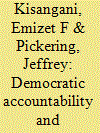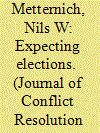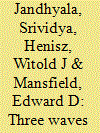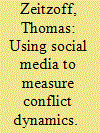|
|
|
Sort Order |
|
|
|
Items / Page
|
|
|
|
|
|
|
| Srl | Item |
| 1 |
ID:
109936


|
|
|
|
|
| Publication |
2011.
|
| Summary/Abstract |
What effect does cheap talk have on behavior in an entry-deterrence game? We shed light on this question using incentivized laboratory experiments of the strategic interaction between defenders and potential entrants. Our results suggest that cheap talk can have a substantial impact on the behavior of both the target and the speaker. By sending costless threats to potential entrants, defenders are able to deter opponents in early periods of play. Moreover, after issuing threats, defenders become more eager to fight. We offer a number of different explanations for this behavior. These results bring fresh evidence about the potential importance of costless verbal communication to the field of international relations.
|
|
|
|
|
|
|
|
|
|
|
|
|
|
|
|
| 2 |
ID:
109931


|
|
|
|
|
| Publication |
2011.
|
| Summary/Abstract |
Third-party states consider the regional destabilization consequences of civil wars when deciding to intervene. However, previous work implicitly assumes that potential interveners base their intervention decisions solely on their links to the civil war country. This approach is unlikely to reflect the regional concerns of interested parties. When a civil war is increasingly likely to infect its surrounding region, potential interveners with strong interests in those states neighboring the conflict will be more likely to intervene to contain the violence. Thus, relationships outside the civil war state-intervener dyad are causally associated with intervention. To test these arguments, the author accounts for the contagious properties of civil wars and the regional interests of third parties, constructing dynamic measures to represent the contagion threat posed to third party regional interests. Analyses of these measures support the argument that third parties are increasingly likely to intervene as the risk of diffusion increasingly threatens their regional interests.
|
|
|
|
|
|
|
|
|
|
|
|
|
|
|
|
| 3 |
ID:
109932


|
|
|
|
|
| Publication |
2011.
|
| Summary/Abstract |
What are the impacts of war on the participants, and do they vary by gender? Are ex-combatants damaged pariahs who threaten social stability, as some fear? Existing theory and evidence are both inconclusive and focused on males. New data and a tragic natural quasi-experiment in Uganda allow us to estimate the impacts of war on both genders, and assess how war experiences affect reintegration success. As expected, violence drives social and psychological problems, especially among females. Unexpectedly, however, most women returning from armed groups reintegrate socially and are resilient. Partly for this reason, postconflict hostility is low. Theories that war conditions youth into violence find little support. Finally, the findings confirm a human capital view of recruitment: economic gaps are driven by time away from civilian education and labor markets. Unlike males, however, females have few civilian opportunities and so they see little adverse economic impact of recruitment.
|
|
|
|
|
|
|
|
|
|
|
|
|
|
|
|
| 4 |
ID:
109937


|
|
|
|
|
| Publication |
2011.
|
| Summary/Abstract |
Agreement on which democratic regime types are prone to use diversionary force has yet to materialize in the embryonic empirical literature on the subject. Nor has consensus emerged on the theoretical approach that best explains the diversionary tendencies of different democratic political systems. By separating out benevolent and belligerent diversionary military missions, we begin to offer some clarity to this mixed empirical literature. In zero-inflated Poisson estimates of fifty-six democracies from 1950 to 2004, we find compelling evidence that a theoretical framework emphasizing leader accountability best explains democratic diversionary behavior. More accountable democratic executives (leaders of majoritarian, weak-party majority, and minority governments) appear significantly more likely to use diversionary force than counterparts with less accountability (especially in coalition governments). Democratic leaders also seem to use benevolent military force for diversionary purposes more often than belligerent force, though they still use the latter in specific contexts.
|
|
|
|
|
|
|
|
|
|
|
|
|
|
|
|
| 5 |
ID:
109933


|
|
|
|
|
| Publication |
2011.
|
| Summary/Abstract |
International organizations (IOs) frequently link their military interventions with democratization efforts in the target state. However, existing research suggests that these attempts often fail. This article analyzes the conditions under which interventions by IOs shorten or prolong civil war dyads. When militarily strong rebel groups with low public support expect externally enforced democratization, they have incentives to continue fighting. These incentives arise when democratization leads to power shifts that cause commitment problems for belligerents with high popular support. Cox hazards models are used to test the article's hypotheses on a new data set on African rebel leaders' ethnicity. The results demonstrate that IO interventions with democratization mandates are only associated with shorter conflicts if rebel leaders come from ethnic groups representing more than 10 percent of a country's population. IO interventions without democratization mandates are not associated with shorter conflict duration and show no interaction effect with the rebels' ethnic support.
|
|
|
|
|
|
|
|
|
|
|
|
|
|
|
|
| 6 |
ID:
109935


|
|
|
|
|
| Publication |
2011.
|
| Summary/Abstract |
How can minority cultures resist assimilation into a global monolith in an increasingly "small world"? Paradoxically, Axelrod found that local convergence can actually preserve global diversity if cultural influence is combined with homophily, the principle that "likes attract." However, follow-up studies showed that this diversity collapses under random cultural perturbation. The authors discovered a new source of this fragility-the assumption in Axelrod's model that cultural influence is interpersonal (dyadic). The authors replicated previous models but with the more empirically plausible assumption that influence is social-people can be simultaneously influenced by several network neighbors. Computational experiments show that cultural diversity then becomes much more robust than in Axelrod's original model or in published variations that included either social influence or homophily but not both. The authors conclude that global diversity may be sustained not by cultural experimentation and innovation but by the ability of cultural groups to discourage those activities.
|
|
|
|
|
|
|
|
|
|
|
|
|
|
|
|
| 7 |
ID:
109938


|
|
|
|
|
| Publication |
2011.
|
| Summary/Abstract |
Bilateral investment treaties (BITs), agreements that provide extensive rights and protection to foreign investors, were first adopted in the 1960s, proliferated in the late 1980s and 1990s, especially among developing countries, and seemingly fell out of fashion after 2001. To explain this life cycle of diffusion across the international state system, we argue that BIT signing followed a traditional logic of diffusion for an innovation albeit here in the policy realm. In the first period, BITs provided a solution to the time inconsistency problem facing host governments and foreign investors. In the second period, these treaties became the global standard governing foreign investment. As the density of BITs among peer countries increased, more countries signed them in order to gain legitimacy and acceptance without a full understanding of their costs and competencies. More recently, as the potential legal liabilities involved in BIT signing have become more broadly understood, the pattern of adoption has reverted to a more competitive and rational logic. Our empirical tests of BIT signing over four decades provide evidence for such a three-stage model.
|
|
|
|
|
|
|
|
|
|
|
|
|
|
|
|
| 8 |
ID:
109934


|
|
|
|
|
| Publication |
2011.
|
| Summary/Abstract |
The lack of temporal disaggregation in conflict data has so far presented a strong obstacle to analyzing the short-term dynamics of military conflict. Using a novel data set of hourly dyadic conflict intensity scores drawn from Twitter and other social media sources during the Gaza Conflict (2008-2009), the author attempts to fill a gap in existing studies. The author employs a vector autoregression (VAR) to measure changes in Israel's and Hamas's military response dynamics immediately following two important junctures in the conflict: the introduction of Israeli ground troops and the UN Security Council vote. The author finds that both Hamas's and Israel's response to provocations by the other side increase (both by about twofold) immediately after the ground invasion, but following the UN Security Council vote, Israel's response is cut in half, while Hamas's slightly increases. In addition, the author provides a template for researchers to harness social media to capture the micro-dynamics of conflict.
|
|
|
|
|
|
|
|
|
|
|
|
|
|
|
|
|
|
|
|
|